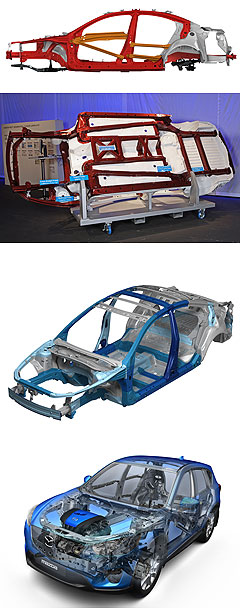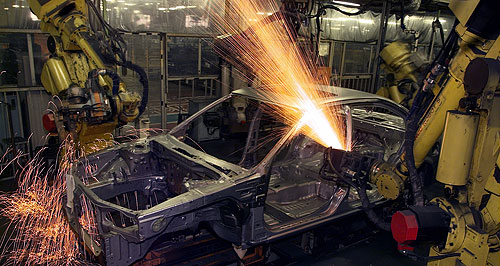Make / Model Search
News - NissanJapanese breakthrough in ultra-tough steelBright sparks: Nissan will commence production of ultra high-tensile steel vehicle bodies from 2013. Super-strong steel set to go into Nissan, Mazda cars as engineers finally tame it6 Oct 2011 JAPANESE car companies Nissan and Mazda have separately announced plans to adopt super-strong steel to shave the weight of future cars without loss of strength, after engineers overcame production hurdles. Nissan says it will use the ultra-high tensile steel – rated at 1200 megapascals on the scale of steel toughness – in vehicle bodies from 2013, saving up to 15kg over conventional steel. Mazda is also pressing ahead with the introduction of ultra high strength steels its new SkyActiv bodies, starting with bars of steel rated at 1800 megapascals in the bumpers of its all-new CX-5 compact SUV due in showrooms in 2012. The race for ever-stronger materials for car bodies – particularly critical areas such as B pillars and roof rails – is the result of the car industry pursuit of the twin goals of improved crash test results and lower weight to cut fuel consumption and raise performance. Nissan said the breakthrough steel – in its case developed by two Japanese steel companies – would allow it to cold-press structural body parts such as centre pillar reinforcements and front and side roof rails in what it described as a significant step in improving environmental impact as well as performance. The company says the new product overcame “significant obstacles” that previously thwarted the application of such high-strength steel in car production, including problems with pressing panels and spot welds. Nissan said previous high-tensile steels were highly rigid, hindering panel stamping “formability”, while spot welds could be inconsistent.  Left: Mazda SkyActiv architecture, including CX-5 SUV detail below. Left: Mazda SkyActiv architecture, including CX-5 SUV detail below.“Traditionally, only high-tensile steel rated up to 980 megapascals (MPa) can be used in cold pressing structural body parts, requiring complex press work,” it said in its media release. “The new 1.2GPa steel, combined with Nissan-developed advances in welding methodology, overcomes both obstacles.” Nissan said the breakthrough involved controlled structural formation at the sub-micron level, combining hard and soft layers to achieve both strength and formability. “Once the new material was developed, extensive experimentation was required to develop an optimal spot-welding methodology,” it said. “This has been achieved with a proprietary process that involves careful optimisation of welding pressure, current volume and power distribution.” Nissan said the new steel would be used globally on Nissan products, reducing the weight of its cars without resorting to high-cost materials such as aluminium. As GoAuto has reported, Mazda is also keen on ultra-high-tensile steel to reduce vehicle weight and maintain strength while keeping costs in check. Mazda’s new production technology uses 1800MPa ultra-high-tensile steel in beams inside the front and rear bumpers that are 20 per cent stronger and 4.8kg lighter than previously. The company said the beams were developed as part of Mazda’s breakthrough SkyActiv body program that incorporates a new energy-absorbing structure as well as an expanded use of high-tensile steel to reduce weight. “Reducing the weight of bumper beams is particularly important because, as they are incorporated into the body structure at the farthest point from the vehicle’s centre of gravity, their weight has a considerable effect on dynamic performance and responsiveness,” Mazda said. “They must also be strong to provide sufficient collision protection. For these reasons, a method of mass-producing the parts using stronger steel has been highly sought after. “However, stronger materials are less pliant and therefore absorb less energy in a collision. To overcome this, Mazda conducted extensive research into how bumper beams deform in a crash and created a new design that absorbs energy more efficiently.” Like Nissan, Mazda also worked on new welding techniques for the metal to establish “a reliable manufacturing process”.  Read more |
Click to shareNissan articlesResearch Nissan Motor industry news |










Facebook Twitter Instagram